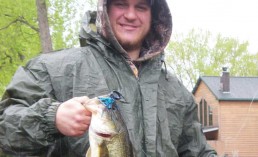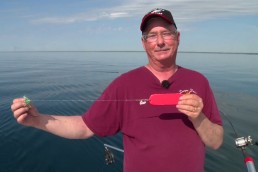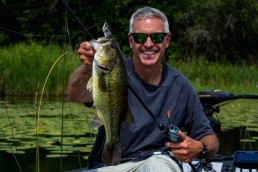Warming Wood Equals Spring Largemouths
SHARE THIS POST
There’s an old saying I grew up with where the words “knock on wood” were really a euphemism for “if we’re lucky,” as in “Looks like a good day. Maybe we’ll catch some fish… knock on wood.”
Early in the bass fishing season, taking that old saying a lot more literal may be in order. Why? Because early in the spring, it makes sense to fish in and around wood. Because wood is an excellent structure that draws largemouth bass early in the season.
I vividly remember one specific outing where I hunted on inside weed lines, expecting fish to be there and be cooperative. After an hour of not much doing, I was perplexed.
While I was figuring out what I did wrong up to that point, I noticed a leaning log back closer to shore in the same area I was fishing. I could just reach it with the jig I was throwing, so I thought, What the heck? and let it fly. The bait hit just beyond the log. I twitched the jig on bottom, then moved it closer to the log. Just before I crawled it over the wood, I had one of those familiar taps. I wasn’t expecting it, but thankfully, instinct was doing its job and I had time to set the hook.
After working the fish back to the boat, I took a little better look around. And saw a number of stumps and logs about the same distance back from the weeds as the log that held the fish that just vacuumed up my jig.
I slowly eased the boat through the weeds and got closer to the wood. Out of eight pieces of wood, ranging from stumps to leaning logs to a few pieces of timber flat on the bottom, I caught six more bass.
The bass were on wood, not weeds, because the water was just a little warmer there and the cover was already solid, while the weed line was not yet fully formed. It’s something I have never forgotten. So, any time I see wood in early spring, I fish it. And a lot of the time, it’s productive.
Wood also gives the bass another protected place to spawn. They back up to the weed edges, as they develop, to spawn and help protect the nest from pillaging. So, spawning on a bottom protected by a stump or log or treetop offers the same benefits, and makes perfect sense. Protection, plus the warmer water are two things that are high on a bass’ list at this time of the year.
Are you enjoying this post?
You can be among the first to get the latest info on where to go, what to use and how to use it!
I prefer getting a bait in an actual spawn bed when possible. A bass can react quite quickly to a foreign object muscling in on its turf in spring. They can hit a bait viciously. But, they can also pick it up pretty gently to swim it out of the protected bedding area.
I like a jig and pig as first choice, with a 4-inch tube rigged on a 4/0 TroKar wide gap worm hook as second. A Senko, rigged weedless on a 3/0 TroKar worm hook can also work wonders on wood fish, twitch it slowly through the area. If that doesn’t work, let it slowly sink toward bottom. If that doesn’t get bit, kill it so it sits motionless on the bottom, preferably in the bed. If a bass thinks it’s a threat, they will pick it up rather quick.
I had that happen once when I got a backlash and had to let the bait sit while I picked line. When I finally got the bird’s nest out and reeled up, the bait was 15 feet away from the tree I had tossed it under. And the fish still had the bait in its mouth.
It’s also good to carry scent with you. Some baits are scented during manufacturing. Some are injected with salt. And some baits have both. I like to put the odds in my favor as much as possible. Bang Crawfish spray is one of my favorites.
One perfect example was when a tournament partner and I found a bass on a nice, neat spawn bed. The only problem was that every time we tossed a salted tube in the nest, the fish bolted. Becoming a bit frustrated, I finally hosed down the tube with scent and flipped it back into the bed. As soon as it hit bottom, the bass was on it like, well, scent on a tube. Could have saved 15 minutes if I had scented it at the get-go.
For that reason alone, I carry scent. And I’ll even use it on baits with scent added, if I think it’ll help the cause. Might as well use the whole buffet line if it means getting a bite.
In retrospect, don’t pass up wood in the spring, no matter what it looks like. I’ve caught fish in very shallow water near small pieces of wood. In some cases, I didn’t see how the fish would be there. The water looked no more than inches deep, and the wood too small to hide anything.
Also, don’t forget where the most productive spring wood is located. With longer days and more sun, those bigger pieces can be used regularly as ambush points and hold fish in the summer, too.
MWO
SHARE THIS POST
Did you enjoy this post?
You can be among the first to get the latest info on where to go, what to use and how to use it!
Tom Luba
Tom Luba is a freelance outdoor writer living in New London, Wis. He has written about open water fishing for more than 35 years.



